by Winding Pathways | Aug 4, 2017 | Nature, Travel/Columns
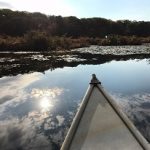
A picture perfect day to canoe.
On a splendid late July day we packed up food, loaded the canoe, paddles and life jackets and headed out to explore the Odessa Water Trail. It’s one of Iowa’s several water trails and part of a larger system of water trails in the Midwest. What a blast!
Two hours south of Cedar Rapids the The Odessa Trail in Louisa County offers a way to explore backwaters safely. It winds through two wildlife management areas. The map we picked up at the Port Louisa National Wildlife Refuge Headquarters ensured we would not get lost in the maze of channels that form the meandering floodplain. Tucked in the inner elbow below Iowa’s bulge with the “Father of Waters” this refuge, managed for waterfowl and wildlife, encompasses 6400 acres and sports three tails ranging from an easy three mile paddle to a moderate 4.5 mile cruise to a 6.5 trek that can extend to 17 miles!
The Refuge closes from mid-September to January first to accommodate migratory waterfowl. Other times it is open to boaters, canoeists and kayakers, fishermen, and birders. Hiking and bicycling trails line the main islands, but those adventures could be dicey in high water and just plain buggy in hot weather. A campground is conveniently located near the Odessa Wildlife Unit Headquarters.
This day was just right. High pressure kept winds down, the sun was warm, but the air cool, especially for July. Sunscreen, long sleeved shirts and hats kept the sun’s rays at bay. Mid summer is quiet for bird life after their busy nesting season. Still we heard and saw a variety of songbirds and kept annoying a Great Egret and at least two Great Blue Herons. They would nervously watch us approach then with a loud squawk lift off and wing a few hundred yards down stream. Only to be annoyed again, when we approached. We did watch a heron catch and swallow a fish.
Along the banks frogs of all sizes croaked and leapt into the murky water. Lots of fish were rising up, but Rich decided not to wet his line, and rather studied the trail map carefully as we floated and paddled. Partway down, we pulled in for lunch balancing snacks in the canoe as the day drifted by.
It was great to try out one of Iowa’s many water trails. Check out the link to the National Park’s National Water Trail System. And, enjoy the short videos and photo gallery below. Go Outside and Play!
Great Egret Flies Off Click this link to see.
Great Blue Heron fishes.
-
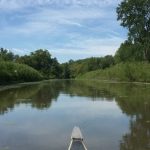
-
Access to the trail is a canal that slows into the Mississippi River.
-
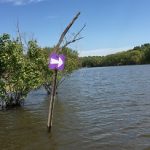
-
Odessa Water Trail is well marked.
-
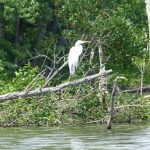
-
Eyeing us.
-
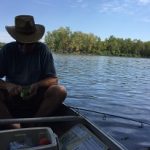
-
In the shade.
-
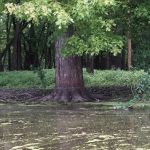
-
Tell tale signs
-
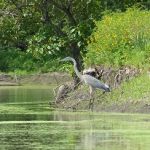
-
Great Blue Heron
-

-
Harbinger of changing weather.
-
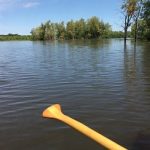
-
Silver Maples beginning to turn.
by Winding Pathways | Feb 28, 2016 | (Sub)Urban Homesteading, Chickens, Energy Efficiency, Geology/Weather, Nature
How ironic that many homeowners don’t harvest the rain that falls on their property, yet they buy water to irrigate their lawn and garden. Harvest free water by using rain barrels and rain gardens.
RAIN BARRELS
Since ancient times families have captured rain falling on their roof to use for irrigation. It worked thousands of years ago and still works today. A rain barrel is a large container positioned under a gutter downspout to catch and hold water for later use. They can be homemade but most people prefer buying one. Hundreds of models are on the market and range from simple and inexpensive ones to elaborately designed barrels that are practical and decorative. We purchased ours from Rainwater Solutions and have placed six under the downspouts of two buildings. The free water irrigates our vegetable garden and provides water for our small flock of chickens. For more information see the Winding Pathways blog of April 2015 or check http://www.rainwatersolutions.com/
RAIN GARDENS
Rain gardens are more permanent than barrels. Like the barrels they range from the simple to the elaborate. Rain gardens aren’t used to harvest water for irrigation but channel roof runoff into the ground rather than into storm sewers.
Our rain garden is simple and cost nothing to create. We dug a shallow basin in the lawn about the size of a bath tub where our downspout discharges gutter water. During a light to moderate rain our rain garden absorbs all the roof water and puts it back into the ground where it moistens roots and eventually helps recharge the aquafer. During a fierce thunderstorm it overflows a little but we channel that to the lawn. Between the garden and lawn all the rain falling on our roof stays on our property, benefiting our plants and not creating flooding downhill.
The Indian Creek Nature Center and Linn County Master Gardeners will hold workshops in March 2016 to help participants learn how to make their own rain garden. Other nature centers, master gardener and Extension Offices hold similar workshops in many locations across the country. Books and websites are available to help homeowners plan their rain garden. One of our favorite information sources is the Low Impact Development Center.
Besides harvesting water and reducing downstream flooding there’s another benefit of having a rain garden. Flowering plants that require wet soil flourish in rain gardens but can’t live in nearby dry soil.
by Winding Pathways | Apr 25, 2024 | Nature, Reflections/Profiles, Travel/Columns
The steep climb got us huffing and puffing until we crested the hill and looked around. Beneath us was a spacious pond and on the far hillside cattle grazed in the evening’s dwindling light. Oncoming darkness, combined with tired leg muscles, encouraged us to circle back to the historic farmhouse where we overnighted.
It sounds like a Montana adventure, perhaps at the spacious American Prairie, but it isn’t. We were at Iowa’s Whiterock Conservancy, a remarkable landscape just south of the tiny town of Coon Rapids in the west central part of Iowa.
What IS Whiterock Conservancy?
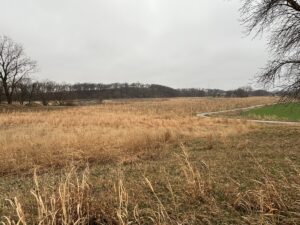
Bike or hike or ride your way along miles of intriguing trails.
Whitrock defies the norm in a state short on places big enough for outdoor enthusiasts who love spaciousness. Winding through its 5,500 acres are about 40 miles of trails that welcome hikers, mountain bikers, equestrians or folks just wishing to walk away from the noise and distractions of modern life. Whiterock is a place to enjoy the quiet and the dark sky of this lightly settled region.
There’s more. Whiterock Conservancy, named for an outcropping rising above a campground, is a testament to the formation of modern agriculture. Roswell Garst farmed the land and enthusiastically promoted hybrid corn. He was a force enabling the land to dramatically increase its production of food.
Entrepreneur, Ambassador, Visionaries
Garst was also an ambassador of sorts and invited his friend, Soviet Premier Nikita Khrushchev, to visit in 1959. The Russian was eager to find ways to expand his country’s food production. For a day the world came to the Garst Farm and Coon Rapids, Iowa. Dignitaries, reporters, and even some possible Soviet Spies were everywhere. The story is that one could tell the “spies” because, in this decidedly farm community, they were the only ones dressed in suits.
The Garst Family was visionary. Rather than sell their land for massive modern agriculture they encouraged the development of the land trust that combines agriculture and outdoor recreation in creative mosaics.
What’s There
After our walk and a picnic dinner, we settled down for the night in the old Garst Farmhouse, marveling at the collection of books, vintage furniture, and artifacts from Khrushchev’s visit inside. Its style was reminiscent of old-time New England homes – low ceilings, a newell post at the end of the stairs, wainscotting, tiled bathrooms, wallpapered ceilings, drapery on the windows, period cookware, and elegant teacups nestled in a corner cupboard. A swing-through door led to the well-equipped kitchen that looked out over a play yard and firepit. We could almost hear Roswell Garst talking up hybrid corn.
How It Came About
The Whiterock Conservancy was created as a nonprofit land trust about 20 years ago. Today it’s a progressive, innovative, and fascinating organization that combines agriculture, ecological restoration, lodging, and outdoor recreation spread over more than 5,000 acres.
We watched the cattle graze, listened as a flock of goats “baaahed” in anticipation of their dinner, drove miles of gravel roads through the property, and walked several trails. Perhaps our favorite was admiring the winter worn prairie grasses and forbs still standing sturdily in a brisk spring wind that rippled the pond’s water.
Things To Do at Whiterock Conservancy
Our short visit just whetted our appetite for the outdoors, and we plan to return. Here are some of many activities welcomed on the land:
-
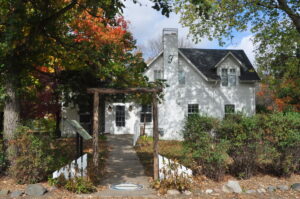
-
Period style farmstead that greeted Nikita Khrushchev. Photo Credit Whiterock Conservancy.
-
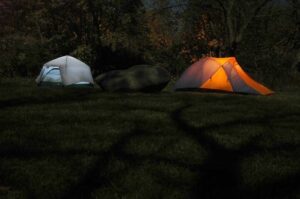
-
Tenting along the river. Photo credit Whiterock Conservancy.
-
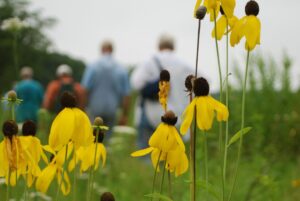
-
The Conservancy hosts a variety of programs. Photo credit Whiterock Conservancy
Camping: Several smallish and rather rustic campgrounds invite overnighters seeking quiet and gorgeous star viewing.
Trails: Well planned and maintained trails wind through hills, prairies, wetlands, and ravines. Hikers, equestrians, and mountain bikers are all welcome.
Home and cabins: Several indoor lodging options range from staying in one of many rooms in the historic farmhouse, to a nearby cottage. There’s even a walk-in cabin.
Activities: Staff and volunteers sponsor periodic programs to help visitors enjoy and appreciate nature and the Conservancy.
Fishing and Hunting: Visitors bearing an Iowa fishing license are welcome to try catching dinner from a dozen ponds scattered about the land. Check with headquarters about bowhunting.
Learn More and Visit!
The Whiterock Conservancy is a nonprofit land trust, funded by donations and grants. A list of fees and information is posted on their website. Donations are suggested for trail users and can be put in convenient boxes near trailheads. We so enjoyed the stay and visit with the staff.
by Winding Pathways | Apr 18, 2024 | (Sub)Urban Homesteading, Garden/Yard, Garden/Yard
Spring Ritual
After this weird winter, most of us in North America are simply ready for spring and want to get outside. Some folks take initiative and start garden and flower seeds indoors then transfer them outside when the weather moderates.
Are you ready to work the land? Try something new: No-till Gardening.
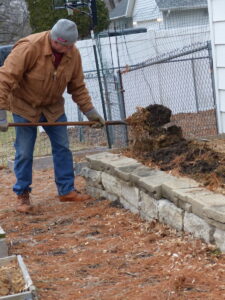
A rite of spring.
For generations, an April ritual all across the northern hemisphere is pulling the spading fork out of storage and firing up the rototiller. For generations, gardeners have learned from mentors, books, and videos that tilling is essential to create an abundant harvest of tomatoes, peas, beans, carrots, and so many other delicious garden vegetables.
Over decades and diligent research, we have learned that tilling is often just extra work that might harm the soil! Try no-till gardening.
Science Writer Shares Information
We recently heard science writer, author, and land steward Connie Mutel speak about how Iowa’s amazingly productive topsoil is being degraded by annual plowing and otherwise disturbing the soil. Mechanically mixing soil bares the soil to the air, where it oxygenates, leaching carbon into the atmosphere. When winds blow or rains fall, bare soil erodes. Waterways become contaminated and silt washes downstream eventually to the Mississippi Delta resulting in damage to commercial fisheries and wildlife there. According to Mutel, half of Iowa’s once 16-inch veneer of topsoil has been lost by tillage. For much more information check out her books available at the University of Iowa [email protected].
Reduce Runoff and Work
Most people aren’t farmers but many of us have backyard gardens. An annual activity is tilling. For years we followed conventional wisdom and used our trusty spading fork to turn over the soil each spring. Not so much anymore.
Last year encouraged by Drew Erickson, Farm Manager, of the Rodale Institute’s Midwest Organic Center, we left about half the garden untilled. “Tilling disrupts the organisms that make soil healthy and productive. “Try no-till gardening. Just plant your seeds in untilled soil,” he advised.
Last spring we tilled half the garden, smoothed out the soil, and planted our seeds.
We didn’t till the other half and just planted the seeds directly into the soil. A few months later we harvested at least as many vegetables from the no-tilled areas as the tilled……and we’d avoided the pitchfork work.
-
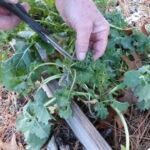
-
We planted kale directly into the ground with good results.
-
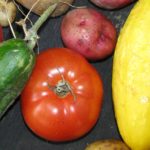
-
Summertime meal from the garden.
This year we’ll only till about a quarter of our garden. Into the rest we’ll plant our seeds and spread a layer of compost directly on the soil surface after the sprouts emerge.
We’re counting on bountiful harvests of many vegetables.
Join the Project
Give it a try. Put onion and potato sets, tomato plants, and bean seeds directly into the untilled garden soil. Let us know the results.
Learn More
Rodale Midwest is holding a free field day to show the value of minimum tillage and cover crops. It’s geared for farmers but gardeners are welcome. To register for the July 9, 2024, workshop go to the Rodale Institute Midwest Organic Center.
Have fun in the garden and enjoy a season of delicious vegetables.
by Winding Pathways | Mar 28, 2024 | Water Resources, Water Resources
(reworked from Iowa’s Wildside Column 8-27-1989)
“When will they ever learn…?” the refrain from Pete Seeger’s song circled in my mind as I reviewed columns, I wrote for the Cedar Rapids Gazette. One stood out. Iowa’s rivers and their then deteriorating condition.
Old Issue Newly Revisited
Over the past 18 months, The Gazette’s environmental writer, Brittney Miller, has addressed Iowa’s poor water quality and its impact on aquatic life.
Ah, yes, when WILL we ever learn? This is a revisit of my column from 30+ years ago.
Iowa is embraced by two of North America’s mightiest rivers – the Missouri and the Mississippi. An interesting network of streams feeds them. The height of land that divides the two drainages follows a barely perceptible rise along a northwest-southeast ridge in the western quarter of the state.
“Let The Rivers Run”
As though Paul Bunyon drew his fingers through Iowa’s geological sandbox, the major tributaries line up in roughly parallel lines flowing southeast to the Mississippi and southwest to the Missouri.
Native Americans and settlers followed these rivers. Later, steamboats, loaded with farm equipment, household goods, and finery pushed their way upstream to then bustling communities. As Iowa’s agricultural economy boomed, grist mills appeared. Farmers exported their grains to Eastern cities along Iowa’s waterways. Emerging railroads and silting waterways hastened the demise of mills. Then, hydropower proved profitable until coal and nuclear power took over.
“Managing” Water
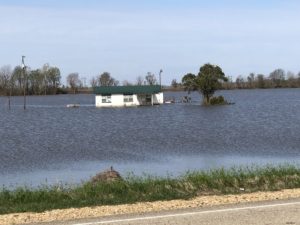
A typical spring scene in the South. Homes under water.
Earliest settlers cussed the Missouri for being too thin to plow and too thick to drink. They couldn’t tolerate its unruly, flood-prone behavior so Congress authorized channeling it with the “Missouri River Stabilization and Navigation Project.” Today, the Missouri is mostly an emasculated drainage ditch – until it rebels and reveals its power, as it has done in recent years.
Consequences
Gone are the oxbows, meanders, belt of trees, and diverse wildlife. Iowans value farmland over natural riparian habitats beneficial to mammals, birds, reptiles, insects, and aquatic life. Oh, and us!
Mighty Mississip
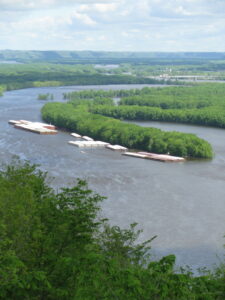
The Mississippi River stretches from Minnesota to the Gulf Coast.
The Mississippi River was dammed and dredged to provide sufficient depth for barge traffic. The dams did create numerous backwaters that support wildlife, but the Great River cannot flush itself out, so it chokes in its own silt. That toxic-laden silt slides downstream poisoning the Gulf and disrupting commercial fisheries there.
What Floodplains Do
Flood plains are areas for all wild and roiling rivers to spend their energy. The dissipated water helps recharge wetlands, and cleanses and naturally replenishes groundwater supplies. Sediment filters out on flood plains, enriching the soil.
Again and Again and Again
As we build and rebuild on flood plains, we keep spending untold dollars trying to conquer the natural elements. As residential, industrial, and agricultural demand for water increases, we rely more heavily on groundwater. That source is stressed, too. The multi-year droughts Iowa has experienced have impacted the aquifers. Lower water tables and tainted water supplies result.
When WILL we learn that our water supplies are important and to treat them respectfully and carefully?


















